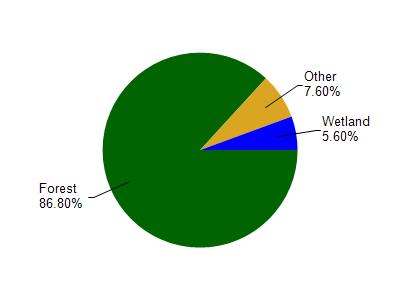Bayfield
Yes
No
No
Fish and Aquatic Life
Overview
Two unnamed tributaries to the Sioux River are classified as trout streams. One is considered an outstanding resource water. It supports a Class II trout fishery, flowing some three miles south from its headwaters in Section 32 T49N R5W. This stream enters the Sioux River in Section 4 in the NENE corner of the section. It supports a resident population of brook and rainbow trout as well as migratory runs from Lake Superior. Wisconsin Trout Streams incorrectly identifies this stream as entering the Sioux River in Section 32 T49N R5W, when it actually meets the Sioux River in Section 4 T48N R5W.
The other tributary is a Class III trout stream for brook and rainbow trout, with some migratory species from Lake Superior. The stunted nature of the fish may be due to a lack of in-stream food sources. This stream originates from wetlands on the southeast end of Long Lake. A six-foot rock water control structure creates a small impoundment in Section 7. Wisconsin Trout Streams has incorrectly identified this stream as entering the Sioux River at T48N R5W S7, which is the headwaters of the stream. It enters the Sioux River in Section 4, NESW.
Date
Author Aquatic Biologist
Condition
Wisconsin has over 84,000 miles of streams, 15,000 lakes and milllions of acres of wetlands. Assessing the condition of this vast amount of water is challenging. The state's water monitoring program uses a media-based, cross-program approach to analyze water condition. An updated monitoring strategy (2015-2020) is now available. Compliance with Clean Water Act fishable, swimmable standards are located in the Executive Summary of Water Condition in 2018. See also the 'monitoring and projects' tab.
Reports
Management Goals
Wisconsin's Water Quality Standards provide qualitative and quantitative goals for waters that are protective of Fishable, Swimmable conditions [Learn more]. Waters that do not meet water quality standards are considered impaired and restoration actions are planned and carried out until the water is once again fishable and swimmable
Management goals can include creation or implementation of a Total Maximum Daily Load analysis, a Nine Key Element Plan, or other restoration work, education and outreach and more. If specific recommendations exist for this water, they will be displayed below online.
Monitoring
Monitoring the condition of a river, stream, or lake includes gathering physical, chemical, biological, and habitat data. Comprehensive studies often gather all these parameters in great detail, while lighter assessment events will involve sampling physical, chemical and biological data such as macroinvertebrates. Aquatic macroinvertebrates and fish communities integrate watershed or catchment condition, providing great insight into overall ecosystem health. Chemical and habitat parameters tell researchers more about human induced problems including contaminated runoff, point source dischargers, or habitat issues that foster or limit the potential of aquatic communities to thrive in a given area. Wisconsin's Water Monitoring Strategy was recenty updated.
Grants and Management Projects
| Project Name (Click for Details) | Year Started |
|---|
|
|
Monitoring Projects
| WBIC | Official Waterbody Name | Station ID | Station Name | Earliest Fieldwork Date | Latest Fieldwork Date | View Station | View Data |
|---|
| 2886500 | Unnamed | 10034355 | Unnamed stream 125m US Long Lake (Wanebo)Rd | 9/14/2011 | 1/1/2015 | Map | Data |
| 2886500 | Unnamed | 10051640 | 17m Upstream from Paulson Rd | | | Map | Data |
|

Watershed Characteristics
Unnamed is located in the Bayfield Peninsula Southeast watershed which is 301.48 mi². Land use in the watershed is primarily forest (86.80%), wetland (5.60%) and a mix of grassland (4.10%) and other uses (3.50%). This watershed has 453.79 stream miles, 291,749.17 lake acres and 6,560.31 wetland acres.
Nonpoint Source Characteristics
This watershed is ranked Not Ranked for runoff impacts on streams, Not Available for runoff impacts on lakes and Low for runoff impacts on groundwater and therefore has an overall rank of Low. This value can be used in ranking the watershed or individual waterbodies for grant funding under state and county programs.However, all waters are affected by diffuse pollutant sources regardless of initial water quality. Applications for specific runoff projects under state or county grant programs may be pursued. For more information, go to surface water program grants.